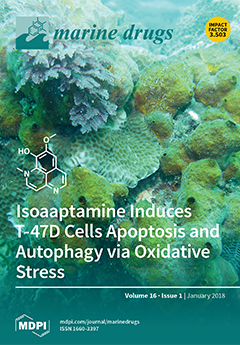Twenty-nine new limonoids—named xylomolins A
1–A
7, B
1–B
2, C
1–C
2, D–F, G
1–G
5, H–I, J
1–J
2, K
1–K
2, L
1–L
2, and M–N, were isolated from the seeds of the mangrove plant,
Xylocarpus moluccensis. Compounds
1–
13 are mexicanolides with one double bond or two conjugated double bonds, while
14 belongs to a small group of mexicanolides with an oxygen bridge between C1 and C8. Compounds
15–
19 are khayanolides containing a Δ
8,14 double bond, whereas
20 and
21 are rare khayanolides containing a Δ
14,15 double bond and Δ
8,9, Δ
14,15 conjugated double bonds, respectively. Compounds
22 and
23 are unusual limonoids possessing a (
Z)-bicyclo[5.2.1]dec-3-en-8-one motif, while
24 and
25 are 30-ketophragmalins with Δ
8,9, Δ
14,15 conjugated double bonds. Compounds
26 and
27 are phragmalin 8,9,30-
ortho esters, whereas
28 and
29 are azadirone and andirobin derivatives, respectively. The structures of these compounds, including absolute configurations of
15–
19,
21–
23, and
26, were established by HRESIMS, extensive 1D and 2D NMR investigations, and the comparison of experimental electronic circular dichroism (ECD) spectra. The absolute configuration of
1 was unequivocally established by single-crystal X-ray diffraction analysis, obtained with Cu Kα radiation. The diverse cyclization patterns of
1–
29 reveal the strong flexibility of skeletal plasticity in the limonoid biosynthesis of
X. moluccensis. Compound
23 exhibited weak antitumor activity against human triple-negative breast MD-MBA-231 cancer cells with an IC
50 value of 37.7 μM. Anti-HIV activities of
1,
3,
8,
10,
11,
14,
20,
23–
25, and
27 were tested in vitro. However, no compounds showed potent inhibitory activity.
Full article






